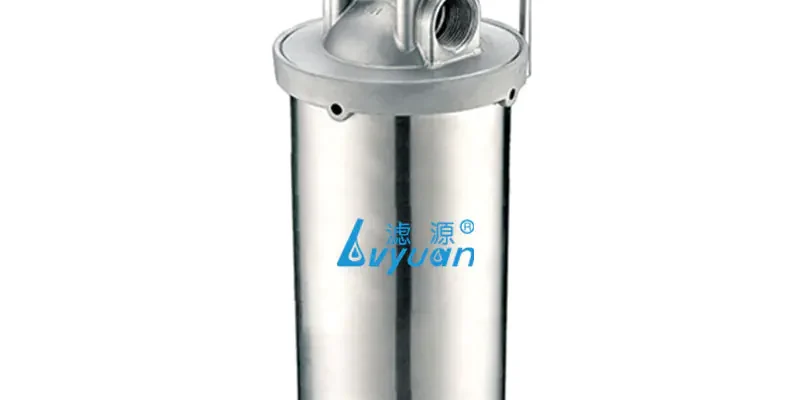Introduction
Water filter housings play a crucial role in ensuring the purity and safety of our drinking water. They provide a protective enclosure for filtration systems, safeguarding them against contaminants and impurities. When it comes to selecting the right filter housing, the choice of material is paramount. In this article, we delve into the comparison between stainless steel and Stainless Water Filter Housing, highlighting why stainless steel emerges as the superior choice.
The Rise of Stainless Steel Filter Housings
In recent years, stainless steel filter housings have gained significant traction in the market. This surge in popularity can be attributed to the numerous advantages offered by stainless steel over traditional plastic housings. Stainless steel boasts exceptional durability, resilience, and longevity, making it an ideal choice for demanding filtration applications.
Downsides of Plastic Water Filter Housings
While plastic water filter housings were once prevalent in the market, they come with their own set of limitations and drawbacks. Plastic housings are susceptible to degradation over time, especially when exposed to harsh chemicals or extreme temperatures. Moreover, concerns regarding environmental impact and recyclability have raised questions about the sustainability of plastic filter housings.
Durability and Longevity
One of the primary advantages of stainless steel filter housings is their unparalleled durability and longevity. Unlike plastic housings that are prone to cracking, warping, or deterioration, stainless steel exhibits remarkable resilience, ensuring prolonged service life and reliable performance.
Resistance to Corrosion and Chemicals
Stainless steel excels in resisting corrosion and chemical damage, making it suitable for a wide range of filtration applications. In contrast, plastic housings may degrade when exposed to certain chemicals, compromising their structural integrity and filtration efficiency.
Temperature Resistance
Stainless steel demonstrates superior temperature resistance compared to plastic, making it suitable for environments with extreme heat or cold. Plastic housings may become brittle or deform under high temperatures, posing a risk of failure and compromising filtration performance.
Hygienic Properties
Another advantage of stainless steel is its inherent hygienic properties. Stainless steel surfaces are smooth, non-porous, and easy to clean, minimizing the risk of bacterial growth and contamination. In contrast, plastic surfaces may harbor bacteria, mold, or other pathogens, potentially compromising water quality.
Maintenance and Cleaning
Stainless steel filter housings require minimal maintenance and are easy to clean, contributing to hassle-free operation and upkeep. Conversely, cleaning plastic housings can be challenging, as they may retain residues or impurities, necessitating thorough cleaning procedures and maintenance efforts.
Environmental Impact
From an environmental standpoint, stainless steel offers several advantages over plastic. Stainless steel is fully recyclable, with a significantly lower environmental footprint compared to plastic. The durability and longevity of stainless steel also reduce the need for frequent replacements, further minimizing waste generation and resource consumption.
Cost Comparison
While stainless steel filter housings may entail a higher initial investment compared to plastic, they offer substantial long-term cost savings. The durability, longevity, and reduced maintenance requirements of stainless steel translate into lower lifecycle costs, making them a more economical choice in the long run.
Applications and Industries
Stainless steel filter housings find widespread applications across various industries, including food and beverage, pharmaceuticals, and water treatment. Their robust construction and compatibility with diverse filtration media make them indispensable in critical filtration processes where reliability and performance are paramount.
Customer Satisfaction and Reviews
Feedback from users consistently underscores the superior performance and durability of stainless steel filter housings. Customers appreciate the peace of mind that comes with knowing their filtration systems are housed in a material known for its reliability and longevity, contributing to overall satisfaction and trust in the product.
Brand Reputation and Trust
The choice of filter housing material can significantly impact brand reputation and trust. Brands that prioritize quality, reliability, and sustainability by opting for stainless steel demonstrate their commitment to delivering superior products and environmental stewardship, thereby enhancing customer trust and loyalty.
Future Trends
Looking ahead, the trend towards stainless steel filter housings is expected to continue as industries prioritize durability, performance, and sustainability in their filtration systems. Emerging innovations and advancements in stainless steel manufacturing techniques may further bolster its position as the material of choice for filter housings.
Conclusion
In conclusion, the comparison between stainless steel and plastic water filter housings unequivocally favors stainless steel as the superior choice. With its unmatched durability, corrosion resistance, and environmental benefits, stainless steel outperforms plastic in every aspect. For industries and consumers alike, investing in stainless steel filter housings ensures optimal performance, longevity, and peace of mind.



